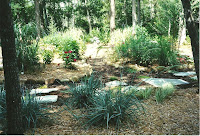The ladies tittered appreciatively, which was very nice of
them. Honestly, I can’t take Tim anywhere.
You should have heard what he came out with yesterday during a discussion
of the capacity for good and evil in all people (in the larger context of
spirituality versus religiosity). “Take Hitler,” he said earnestly. “I’ve heard
he was very good at barbecuing.”
Talk about a conversation stopper.
Anyway. I brought up the DAR thing because, as usual, our
presentation included a plug for this blog and my email address for any
questions listeners may have after we’ve packed up our miles of cables and gone
home. A few days later, Miss Nadine wrote to ask what post contained the
pictures of the deer-resistant containers we’d shown. I explained that I haven’t
used those photos in the blog yet, and sent her copies. And then the light-bulb
over my head flashed on—how about a post about drop-dead-gorgeous summer
containers?
| Delphinium plants from Christine |
I love Christine.
| Sempervivum assortment from Christine |
| White vinca & raspberry supertunias |
The simple secret to killer containers is to pack in the plants. We jammed this 42” hayrack with 18 3” white vinca and 8 4” ‘Raspberry Blast' petunias in May. I snapped the picture in July.
| Where's the pot? |
You can’t even see the 16” pot holding this lush planting of a one-gallon red fountain grass (Pennisetum setaceum var. rubrum), 12 3” mixed-color vincas and a 4” fanflower (Scaevola aemula ‘Blue Wonder’) planted in May and photographed in July.
Restraining my inclination toward horticultural experimentation, I stick with tried-and-true plant combinations
for clients. Hanging in full sun, a set of stacked hayracks—36” long on top,
42” below—are stuffed with as many vinca and petunias as I could cram in, about three full flats to fill the pair. For a same-sized hayrack duo
in full shade, I used an equal number of impatiens.
| Stacked hayracks for sun |
| Stacked hayracks for shade |
| Heat-loving petunias |
Consider the conditions around your containers. These petunias can take all the reflected heat the bricks radiate without wilting or singeing. Many other plants—wishbone flower (Torenia fournieri), for example—can’t.
To make life easier on yourself, combine plants with similar watering needs. A full-sun, deer-resistant vignette of one 12” and two 10” pots, photographed at the time of planting, includes red pentas, fanflower, vinca, ‘Diamond Frost’ euphorbia, ‘Black Prince’ ornamental pepper, marigolds and various tender sedums, all of which share moderate-to-low moisture requirements. Succulents offer a veritable cornucopia of shapes, sizes and colors for low-to-no-water containers. Here's a pinky-grey Echeveria anchoring an assortment of sedums. (Be sure to look for my article on designing with succulents in the May issue of Carolina Gardener magazine, sold in fine garden centers, available soon.)
| Combine pots to create vignettes |
| Be careful in your choice of perennials to mix with annuals |
Mixing perennials with annuals can be tricky, as the former have more extensive root systems and will commandeer more below-the-surface space. Ornamental grasses, for example, can easily take over the lion’s share of a container’s water and available nutrients to the detriment of their neighbors. Still, some plants play well with others, as demonstrated by this perennial blue-flowered mealycup sage (Salvia farinacea ‘Evolution’) blending nicely in a 12” terracotta pot with the annuals ‘Alabama Sunset’ coleus and ‘Raspberry Blast’ petunia.
| Mangers following the recipe |
Pushing the container envelope may be an attractive notion to those whose motto is “Think Big.” Here are some before-and-after photos of a pair of small raised beds cum really big containers Tim and I designed and built for one of our favorite clients to unclutter and unify her backyard.
 |
| Building bigger containers... |
| ... and filling them |
| Plain & simple |
Sometimes, simplest is best. Here are three orphan petunias I tossed in a spare pot late last summer. They didn’t do much at the time, but stayed green through our mild winter: they started blooming last week. I’m looking forward to a long season of this single-species flowering powerhouse decorating the corner of our sidewalk. Nothing fancy, but an attention-grabber just the same.
Big, small, or
in-between, containers with punch have packed-in plants. You won’t be sorry you
spent the money.
Thanks for
dropping by.
Kathy





















